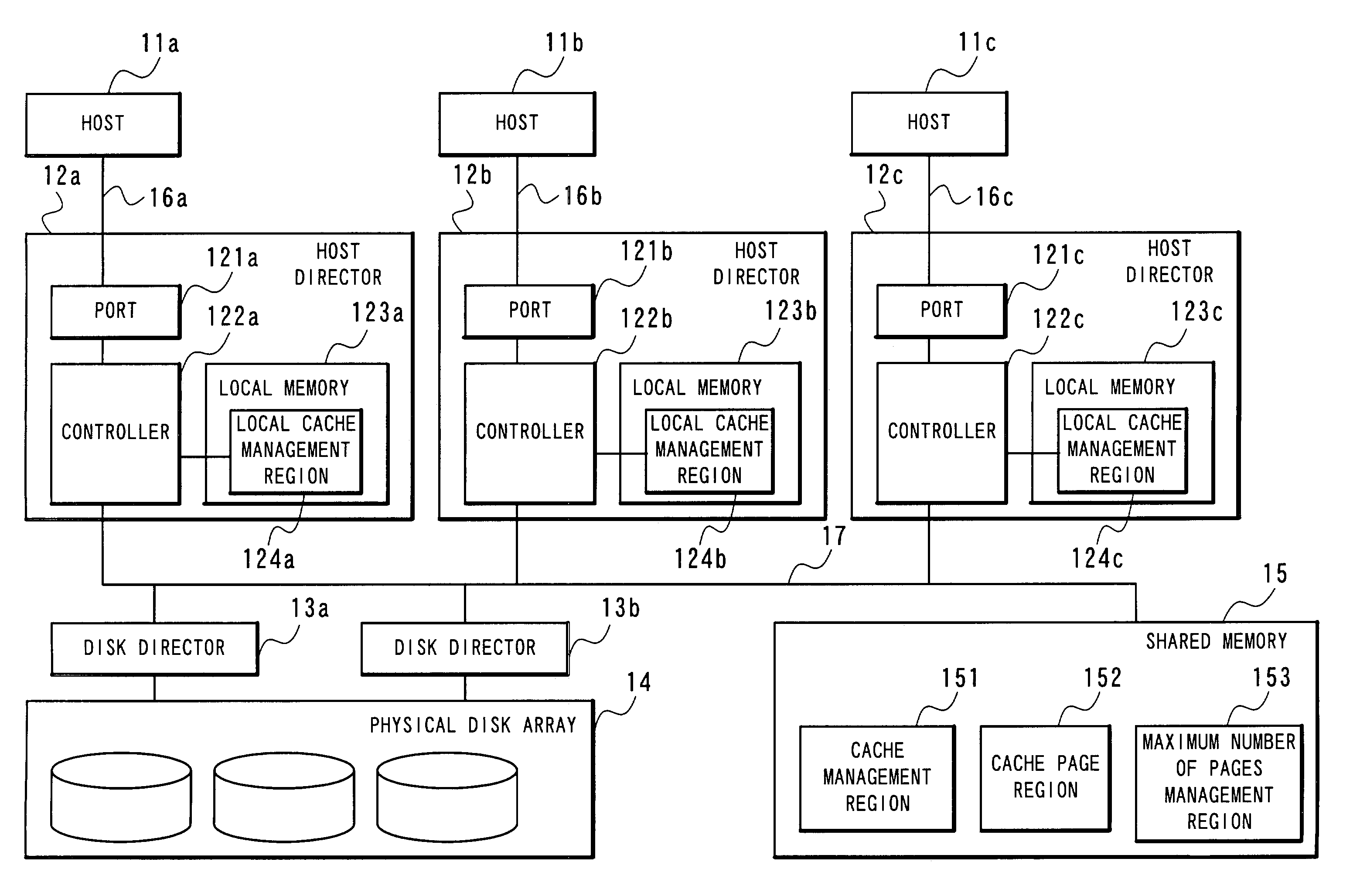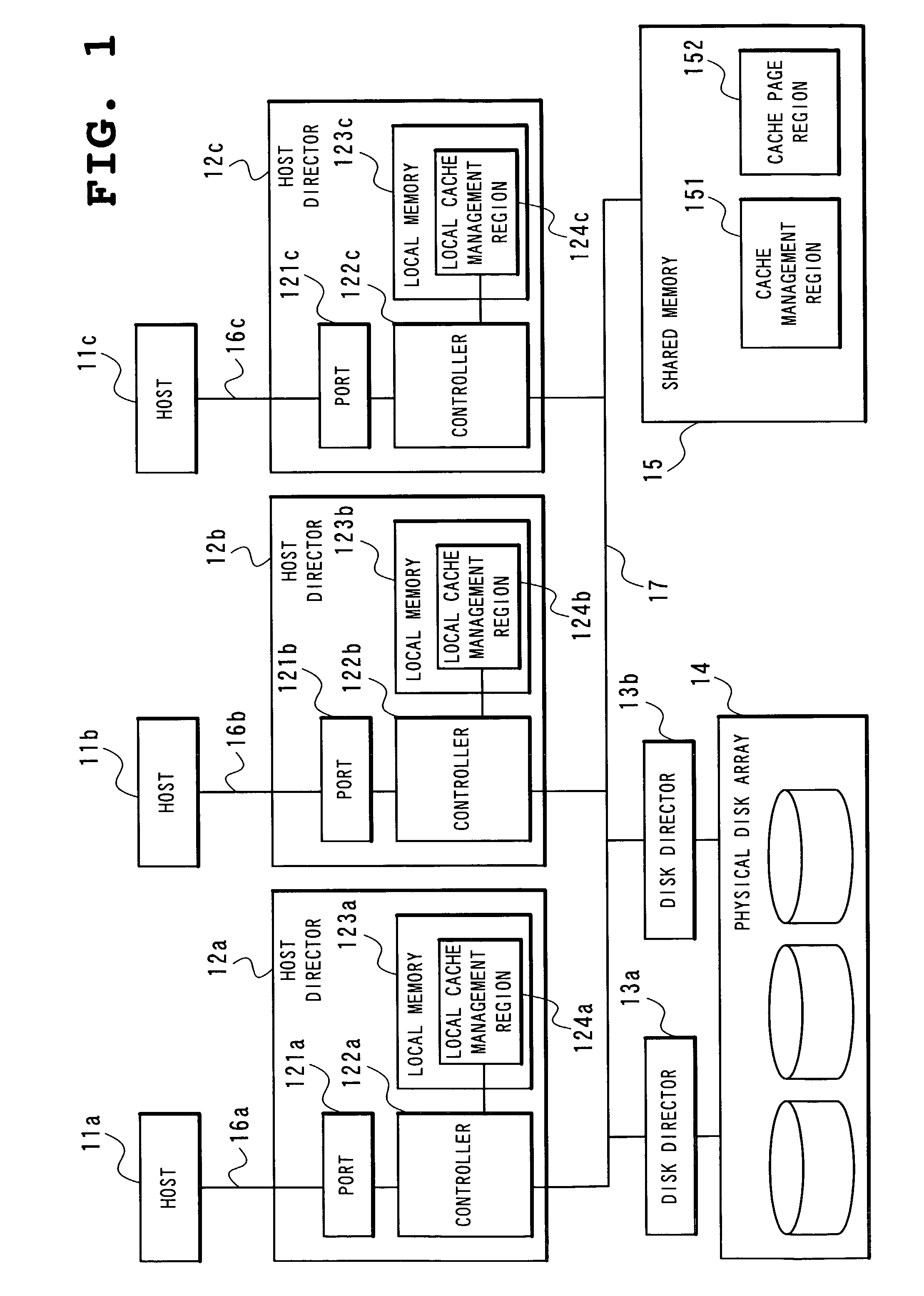Disk cache management method of disk array device
a technology of disk array device and management method, which is applied in the direction of memory address/allocation/relocation, input/output to record carriers, instruments, etc., can solve the problems of relatively bottlenecked processing performance, rapid response, and increased processing costs, so as to improve cache page access response performance and eliminate performance bottlenecks
- Summary
- Abstract
- Description
- Claims
- Application Information
AI Technical Summary
Benefits of technology
Problems solved by technology
Method used
Image
Examples
first embodiment
[First Embodiment]
[0113]FIG. 1 is a block diagram showing a structure of a disk array device to which a disk cache management method according to a first embodiment of the present invention is applied. The disk array device includes, as main components, a plurality (three illustrated in the figure) of host directors 12a, 12b and 12c to which a plurality (three illustrated in the figure) of hosts 11a, 11b, 11c are connected through channels 16a, 16b and 16c, respectively, a plurality (two illustrated in the figure) of disk directors 13a and 13b connected to the host directors 12a, 12b and 12c through a bus 17, a physical disk array 14 connected to the disk directors 13a and 13b, and a shared memory 15 connected to the host directors 12a, 12b and 12c and the disk directors 13a and 13b through the bus 17.
[0114]The host directors 12a, 12b and 12c are composed of ports 121a, 121b and 121c, controllers 122a, 122b and 122c and local memories 123a, 123b and 123c, respectively.
[0115]The port...
second embodiment
[Second Embodiment]
[0180]Since the first embodiment is premised on that the maximum number of cache pages at the steady open state is a static basic value, fixedly used is, for example, a value obtained by evenly dividing a certain rate of the total cache pages as a maximum rate of cache pages at the steady open state by the number of host directors mounted on the disk array device. In some of disk array devices mounted with a plurality of host directors, a certain host director might not be connected or might not receive a read / write command so frequently and required performance might vary depending on a host connected. Described in the second embodiment is a method of varying a maximum number of pages at the steady open state by a host director based on a reference value set in advance and dynamically changing the maximum number of pages according to the actual number of commands received recently.
[0181]FIG. 7 is a block diagram showing a structure of a disk array device to which...
third embodiment
[Third Embodiment]
[0184]FIG. 9 is a block diagram showing a structure of a disk array device to which a disk cache management method according to a third embodiment of the present invention is applied. The disk array device differs from the disk array device shown in FIG. 1 to which the disk cache management method according to the first embodiment is applied only in further including host director programs 100 for the respective host directors 12a, 12b and 12c of the disk array device.
[0185]The host director program 100 is read into each of the host directors 12a, 12b and 12c to control operation of each of the host directors 12a, 12b and 12c completely in the same manner as that for the operation of the host directors 12a, 12b and 12c according to the first embodiment. Therefore, no detailed description will be made of operation of the disk array device to which the disk cache management method according to the third embodiment is applied.
PUM
 Login to View More
Login to View More Abstract
Description
Claims
Application Information
 Login to View More
Login to View More - R&D
- Intellectual Property
- Life Sciences
- Materials
- Tech Scout
- Unparalleled Data Quality
- Higher Quality Content
- 60% Fewer Hallucinations
Browse by: Latest US Patents, China's latest patents, Technical Efficacy Thesaurus, Application Domain, Technology Topic, Popular Technical Reports.
© 2025 PatSnap. All rights reserved.Legal|Privacy policy|Modern Slavery Act Transparency Statement|Sitemap|About US| Contact US: help@patsnap.com



